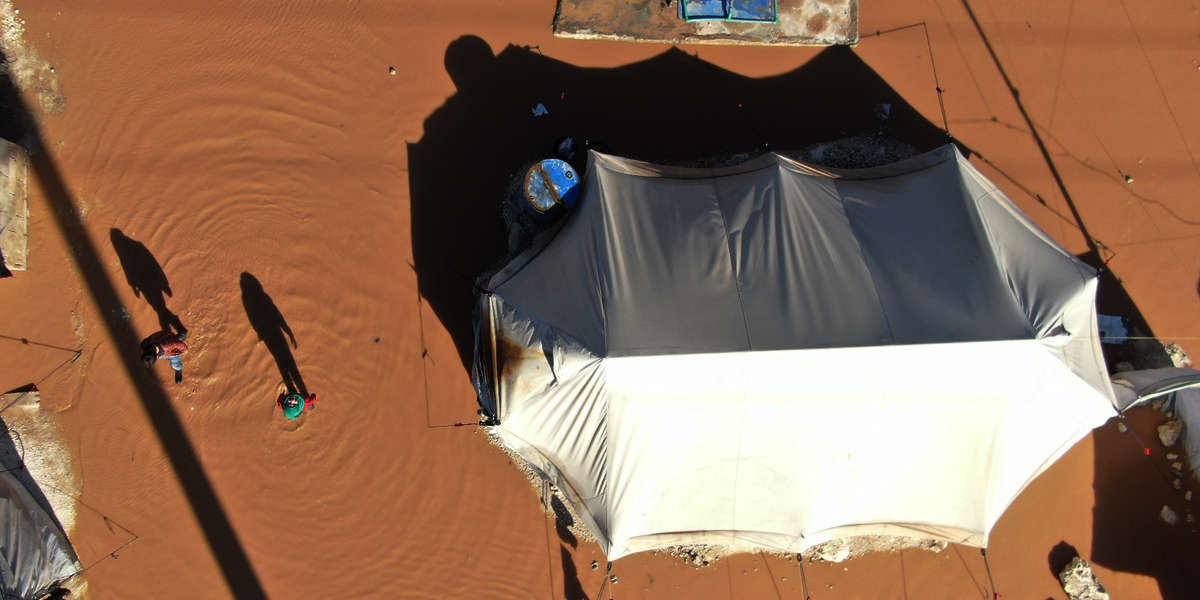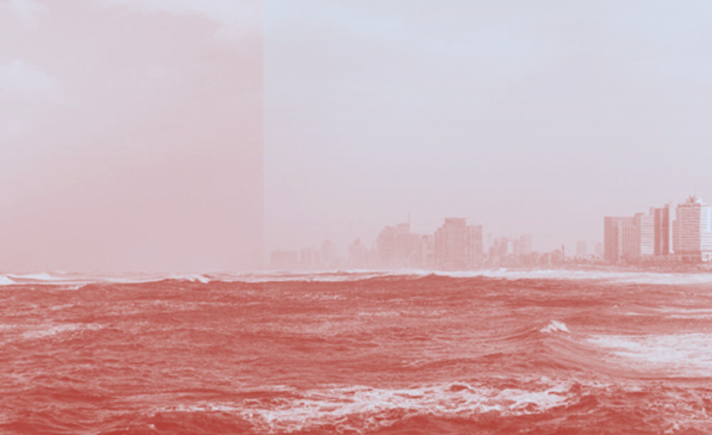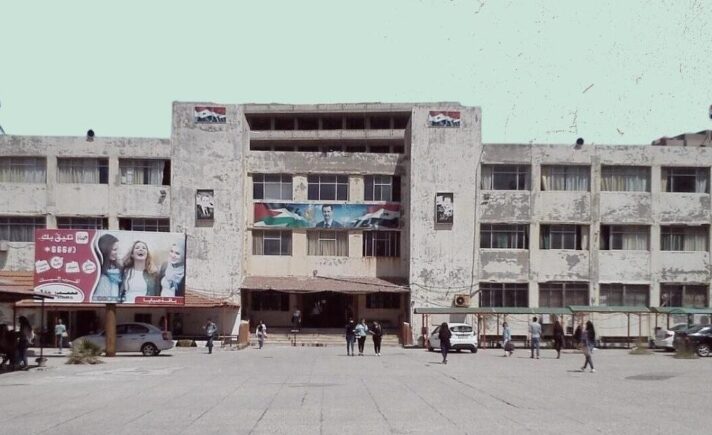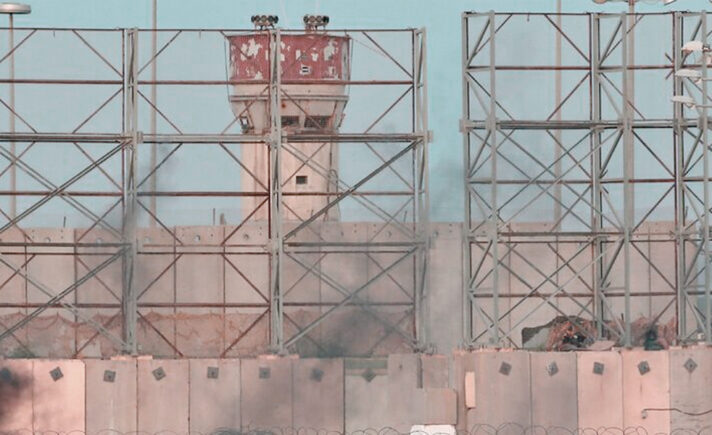The two-word farewell became the lyrics of a song. Its melody enveloped the long columns of cars as newly displaced families fled the hell of Russian airstrikes and Syrian regime forces, which were rapidly advancing on rural Aleppo, Hama and Idlib governorates in 2019.
‘Goodbye, house’
This was the title of videos that began spreading across social media at the time. Perhaps the most famous of them was a one of Habib al-Taataa, an elderly man, tearfully bidding farewell to his house in Kafranbel, a town in southern Idlib governorate. In other videos, people said goodbye to their homes, using those same words — “goodbye, house” — that later became the lyrics to a song by Syrian musician Abu Maher al-Saleh. It became the theme music for the mass displacement occurring at the time, which the UN described as “the biggest single displacement of people since the conflict erupted” in 2011.
This wave of displacement placed northwestern Syria in the midst of an unprecedented housing crisis. According to the most recent statistics from the Response Coordination Group, “the number of displaced Syrians at the time reached 2.1 million people, out of a total of more than four million Syrians living in opposition-held areas.” Meanwhile, the group noted, “there are 1,043,869 displaced people living in 1,293 camps, 282 of which are informal camps set up on farmland and which do not receive any support or international humanitarian aid.”
The main destination for these displaced people was the Syrian-Turkish border. Towns and villages there witnessed an explosion of urban growth and unorganized construction on land that was not equipped with the infrastructure to support large numbers of residents.
Home prices spiked in those new communities, with rent for some houses reaching more than $200 per month. This came amid increased numbers of displaced people arriving as swathes of formerly opposition-held territory fell back into the hands of regime forces. The economic situation was also deteriorating, with many displaced Syrians now finding themselves below the poverty line.
For the majority of the newly displaced, their first destination became the camps. These camps ballooned, especially the ones located in the Atma floodplain close to the Turkish border, where the very first camps following the 2011 revolution had begun to appear. It was here that pictures and videos began to reach the world of Syrians suffering amid harsh conditions. Perhaps the most famous of these videos is one of the poet Nader Shalash, who himself had been displaced from his home village of Kafrnabudeh in 2012. Shalash introduces, perhaps, a new form of poetry in his video–the poetry of the Syrian diaspora’s onward march. He wrote a diwan, or collection, of poems titled al-Atmiyat, in reference to the Atma camps where he sought refuge. The handwritten collection contained Shalash’s most famous poems, which he sang while in tears before the lens of a mobile phone camera in 2012:
I sent my soul home, to float about in it
When our steps have no way to reach it
For you to ask if home remembers us
Or did it forget when its people left?
And yet my soul will still reside in you, home
In Atma I have neither sheep nor camel
Nader Shalash died and was buried in Atma on September 12, 2012.
The beginning of the story
But let us return to the roots of the camps’ inception. From these roots emerge the reasons for the current challenges and the crisis that has only accumulated over the years, leaving in their wake hundreds of thousands of people in tents that hardly provide any advantage over sleeping in the open.
In 2012, as Syrians began fleeing the hotspots of regime bombardment and the battles between rebel and regime forces, the displacement camps began to coalesce uneasily–albeit completely in line with the brutal conditions displaced Syrians faced at the time. The only advantage in the camps’ location near the border was their relative distance from the frontlines, as well as from the regime’s indiscriminate airstrikes and artillery fire.
The difficulties that displaced people soon found themselves in meant they were unable to ascertain a camp’s habitability before moving in. In addition, there weren’t yet any humanitarian organizations in opposition-held territory that could provide the necessary support. Instead, displaced people relied on the individual efforts of volunteers who had not studied the local topography, and who didn’t know to set up the camps away from waterways and on higher ground that wouldn’t flood each winter.
Humanitarian organizations in northwestern Syria subsequently found themselves in a dilemma. Hundreds of thousands of displaced people had settled in uninhabitable places where the the response effort would prove difficult, especially any wintertime rescue operations from security incidents, bombardment or fires. And amid all this, many of the camps were set up within a floodplain that was submerged every winter–a reality that forced organizations operating in the area to sound alarm bells at the start of each winter season.
The making of the Syrian tent, and its subsequent forms
Blankets, some wooden and metal poles, and simple plastic tarps came together to form the first displacement tents. At first, these tent contained only small bags, which the displaced carried during their journeys. There were plain mattresses given by volunteers, not nearly sufficient to cover these families’ needs.
Later, as their displacement stretched out over time, it became necessary for the displaced and for local volunteer teams to find more effective options. Some people started producing tents locally, while others got their hands on ready-made tents and distributed small numbers of them to families in need.
With ever-increasing displacement and the lack of any clear end to the suffering, the volunteer teams’ work became more institutionalized. A new era began, one that witnessed the formation of numeruos local aid organizations. The areas covered by international aid groups also expanded as they began working with local affiliates.
Housing was a top priority for these organizations. And so the image of the typical Syrian tent quickly began to take shape in the north as the number of tents grew to an unprecedented number, their many different shapes and colors indicitave of which group had provided them.
Shipwreck in a sea of mud
The tragic scene repeats itself each winter, captured by journalists’ cameras and shared on social media, often in the form of aerial photos. The pictures are perplexing at first: a big, red lake of mud surrounding what appears to be a ship, floating, fixed in place despite the storm. The scene quickly reveals itself. The ship is what camp residents refer to as a UN “ship tent” the kind that fills many of the camps of northwestern Syria–especially those in Atma, in the northern countryside of Idlib governorate.
“I cannot describe the hell I lived through in the ship tent,” says Jihad al-Muhammad, 32, who lives in a camp run by aid NGO Maram in rural Idlib. The old tents have since been replaced with so-called “refugee housing units,” RHUs, now offered by local and interntional organizations alike as a temporary solution to the tragedy of displacement.
Muhammad no longer lives in a ship tent, but tens of thousands of displaced Syrians still do, despite the tent being hardly suitable even for a short camping trip. It lacks any kind of privacy, as its “walls” are formed of transparent plastic sheets that restrict the lives of those inside. Turning on the lights in the evening renders any movement inside the tent completely clear to passersby.
Displaced people stave off this problem by covering the tent with blankets that block out light, but still they remain helpless to other problems. Mostly there is the tent’s rapid deterioration and its inability to stand up to weather, especially rain and snow. There is also the low “roof,” according to specifications detailed by the tentmaking company itself, which makes standing inside of it unpleasant. The tent is meant to shelter only five people for a year in the best conditions.
“During the last 11 years of the Syrian crisis, more than USD1 billion has been spent on tents, when you consider all the people who were living in tents in refugee camps when they first left the country–in places like Jordan and Lebanon and Turkey–as well as all the millions of people internally displaced inside Syria. Humanitarian [organizations] have been giving people tents from the first year of the war until now. And yet these tents don’t last for long in these climactic conditions. They only tend to last six months or one year and then need to be replaced. It’s very expensive to keep replacing tents every year–and not only that, but it is really unacceptable that any family is expected to live in a tent for more than a year, never mind two years or three years or more.” –Mark Cutts, UN Deputy Regional Humanitarian Coordinator for the Syria Crisis
In the short-term, the temporary housing solution provided by the RHUs seems acceptable to many of the displaced. But this issue could change over time, as people remain subject to the wear and tear of the tent’s limited lifespan.
“There is no comparison between life here and our former lives in our homes,” Muhammad says. “But compared to how we were living before as displaced people, this [RHU] is a big improvement. As for the conditions for other displaced people who are living in the informal camps, I’d say that our condition here is much better.”
Other types of tents
After the ship tent, the AFAD tent is the next worst type, named after the Turkish aid organization that provides it. It is also known as the “jamalon,” or gable, tent. What makes this tent a slight improvement is the quality of its materials. Still, however, its walls stand straight up from the ground, making it at constant risk of being blown over by storms and gusts of strong wind.
The “qows,” or bow, tent is preferred by many displaced people, as it is locally made. It has the curved shape of an archer’s iron bow, covered in plastic tarps that give it the advantage of wind resistance while remaining somewhat immune to heavy snowfall and rain.
But none of these tents provide options for a life of real dignity–in other words, they do not meet the minimum requirements for a decent life. The problems begin not at the lack of privacy or the discomfort of living inside the tents, but rather on the general grouping of the tents, attached one after the other in many of the informal camps, increasing the spread of fires caused by crude wintertime heaters. This is not to mention the lack of facilities in these camps, forcing residents to go outside their tents to use bathrooms that either lack enough privacy or have none at all.
In the first half of 2022 alone, there were “275 fire incidents, leaving five people dead and 81 injured, most of them children,” according to Mark Cutts, the UN’s Deputy Regional Humanitarian Coordinator for the Syria Crisis.
These dangers have prompted Syria-focused aid organizations, especially those working in the camps, to search for alternatives. M. H. is a worker for the UN who preferred to remain anonymous as he was not authorized to speak with the media. He said that the main problem with replacing the tents with more permanent structures “that would ensure a decent life for the displaced” is that such a solution “is up to the political will of the countries providing humanitarian support, which view such efforts as starting a form of reconstruction process and contributing to demographic change in the region.”
And as the situation for Syria’s displaced worsens each year, the search for other options begins. “The options on the table were caravans, cement houses with metal roofing and RHUs,” M. H. said. “The first and second options were rejected because of their high costs, but they will remain on the list if there is enough funding to implement them [later]. However, the [RHU-style shelters] have already begun being implemented in a number of places, such as the camps that were set up by the Maram and Watan organizations.”
RHUs
It is a confusing name, and at first I worry that I’m in the wrong place. I’m supposed to be on a tour of the “housing” offered to displaced people as a better alternative to the tents.
The camp is organized, clean and surrounded by a fence. There are lampposts everywhere. But a general view of the place makes you feel uncomfortable. It is a place filled with people, yet life here somehow has no heartbeat. You look around and you see no colors except for the blinding white sun of high noon. You tell yourself that maybe a few trees could help break up the terrible monotony, in this place where you must read the number of the shelter you wish to enter because that’s the only thing to distinguish it from all the others. Long rows of the shelters sit surrounded by white gravel, but really they’re no more than tents with extra features. There is a bathroom and a toilet for each shelter, and from the outside they look nicer than the other types of tents still in use elsewhere in Syria.
You open the plastic door of one of the shelters, and you feel the hot air envelop you. In the middle of summer, sitting inside the RHU does you little better than simply staying outside. If you’re lucky, you’ve been able to cover the floor with cement instead of gravel. And if you’re even luckier, you’ve added two rows of cinder blocks to serve as a small seat indoors.
“RHUs are not an alternative to [permanent] housing units; they are an alternative to tents in emergency situations and in situations where it is impossible to use housing units,” according to Abdulaziz, a program manager for the Ataa organization, which has constructed displacement shelters in Idlib. “As for improving the situation of shelters in northwestern Syria, we believe that each area is different. RHUs can be a very decent option in some places, while at the same time they can be unacceptable if they are being considered as an alternative to permanent housing units or cement dwellings.”
In the homes of the displaced
“I won’t move from here, even if someone granted me a rent-free house in the city,” says Muhammad Kheir al-Ibrahim, 67 years old. He lives in a camp in rural Idlib run by Maram, an NGO. The harsh conditions that Ibrahim and his wife have faced since becoming displaced made the RHUs that they now live in feel like a compromise–one that spares them the hardship of moving from one home to another.
“I’ve suffered a lot from the high rental home prices and moving from place to place. We are comfortable here after the old tents were replaced with this [dwelling]. Either I return to my village of al-Rayyan in the outskirts of Saraqeb, or I die here, where there are decent services, water and sanitation. This place provides much more privacy than the normal tents,” Ibrahim says.
Ibrahim’s 67-year-old wife, Ruqayya al-Ibrahim, helps their two children, who have special needs. She says she struggles to afford their medications, which are expensive. “My daughter was off her medicines for two days, and she couldn’t sleep during that time.” She says the shelter is decent but needs additions. “We’ve asked multiple times to be provided with insulation for the ceilings and floors.”
Some people have added their own personal touches to the RHUs to improve their day-to-day lives. And despite the many downsides to this new type of dwelling, there is a near unanimity among camp residents whose older tents were replaced by the RHUs that the latter is a big improvement. Still, perhaps the biggest issue with the RHUs, according to the people we interviewed, is their high internal temperature. Ibrahim al-Saleh, a 32-year-old from the village of Uqayrbat, now residents in a camp run by Maram in rural northern Aleppo governorate. He says the older tents were better in terms of temperature, as “the new housing is cold in the winter and very hot in the summer.”
We interviewed other people in the rural Aleppo Maram camp, some of whom complain of water shortages due to the water pump sitting at a distance from their shelters. But others in the camp say they believe the water supply is decent. The sewage networks are also fair, they say, as the issues of widespread sewers within the camps, as well as foul smells, are almost gone. The lighting at night is also good, residents say, as the camp has been provided with solar panels mounted on poles. However, these improvements remain insignificant in the eyes of many displaced people amid low-quality education services.
“I have five children,” says Ahmad al-Abdallah, a 40-year-old in the Maram camp. “I’m an illiterate man but I want an education for my children. The education is bad here.”
Omar Hamsho, a 33-year-old camp resident from Aleppo, says he has the same problem. “I only sent my children to the school for two months. I had to stop because the children were coming home from school having learned swear words and insults. Later I resorted to sending them to the mosque so they could learn reading, writing and the Qur’an.”
Health conditions are also not ideal. According to Hamsho, those in need of medical care must “travel several kilometers away to the clinic in the town of Ihtimalat, because the camp has no clinic.” Hamsho suffers from a stomach ulcer–once, when he was in severe pain that required treatment, he couldn’t find an ambulance to take him to the nearest hospital.
A return home
In the camps, priorities differ from one displaced person to another. Households with many family members suffering from unemployment prioritize food aid, especially bread. Other people complain of scarce medical services. But, sooner or later, everyone wants to return to their original home.
Life remains largely similar from one camp to the next, whether in the informal camps or those run by NGOs like Maram, Ataa and Watan. Of course, the organizational differences and additional services makes everyday life for people in the later more comfortable.
There is waning interest in finding an alternative solution for displaced Syrians to return home, as this solution is linked to the regional and international understandings as well as national interests that do not see Syrians as a priority. And so the solution that remains on the table today is simply to secure a less miserable existence for the hundreds of thousands of children, women and men who have been robbed of their most basic rights to a decent life. Indeed, many local and international organizations have recently launched online campaigns similar to the one #حتى_آخر_خيمة, meaning “until the last tent.”
This issue is related in large part to the solutions that organizations working in Syria have so far offered, as well as integrating these solutions with one another in order to cover any weak points remaining in the emergency displacement centers. The words of Ahmad al-Abdallah, the father we spoke with in the Maram camp in rural Aleppo, were not simply a plea for better educational services. Rather, his words were part of an implicit call from a generation of displaced parents who have seen the depth of misery around them and analyzed its causes, spurring them to demand that the next generation not be forced to live with the same problem–in this case, the lack of education.
RHUs, or even prefabricated caravans or cement houses, will not end the journey of suffering for these people. That is, unless the local and international communities join their efforts to find integrated, more permanent and realistic solutions. These solutions must ensure that aid does not go to waste, and that it is best utilized while also including the beneficiaries themselves in the process. After all, they are the ones who best know the difficulties in which they live.
Munzer al-Muhammad, a man from the village of al-Amiqa, now lives in one of the displacement camps of northwestern Syria. He hopes that a portion of the jobs inside the camp will go to camp residents themselves. He says that taking matters into their own hands can improve the quality of services, especially if the camp residents receive work training and are given the opportunity to refine their expertise.
This investigation has been published with support from Reelink Media





